|
|
The Holy Martyr Callinicus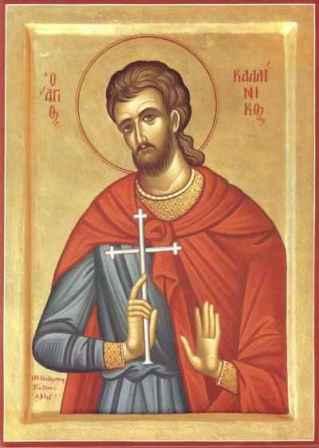 Born in Cilicia and brought up in Christian piety, he left all and began to preach the Gospel. He was arrested in Ancyra by the pagan governor, Sacerdos. When the governor, in fury, threatened him with torture if he would not worship idols, St Callinicus replied: "Every torture for my God is as welcome to me as bread is to a hungry man." After harsh torture and beating, the governor shod him with iron shoes, with the nails sticking inwards, and ordered that he be driven out to the town of Gangra, for he did not dare to have him further tortured or killed in Ancyra, as many men, beholding the heroic endurance of the man of God, were turning to the Christian faith. On the way, the soldiers became thirsty and there was no water. St Callinicus prayed to God and brought forth water from a rock. When they arrived in Gangra, the torturers threw Callinicus into a fiery furnace. The saint prayed to God, saying: "I thank Thee, O heavenly Father, that Thou makest me worthy in this hour to die for Thy holy Name!" He then went into the fire. When the fire was extinguished, his dead body was found whole and untouched by the flames. He suffered with honour, and was crowned with a wreath of eternal glory, in about 250. Born in Cilicia and brought up in Christian piety, he left all and began to preach the Gospel. He was arrested in Ancyra by the pagan governor, Sacerdos. When the governor, in fury, threatened him with torture if he would not worship idols, St Callinicus replied: "Every torture for my God is as welcome to me as bread is to a hungry man." After harsh torture and beating, the governor shod him with iron shoes, with the nails sticking inwards, and ordered that he be driven out to the town of Gangra, for he did not dare to have him further tortured or killed in Ancyra, as many men, beholding the heroic endurance of the man of God, were turning to the Christian faith. On the way, the soldiers became thirsty and there was no water. St Callinicus prayed to God and brought forth water from a rock. When they arrived in Gangra, the torturers threw Callinicus into a fiery furnace. The saint prayed to God, saying: "I thank Thee, O heavenly Father, that Thou makest me worthy in this hour to die for Thy holy Name!" He then went into the fire. When the fire was extinguished, his dead body was found whole and untouched by the flames. He suffered with honour, and was crowned with a wreath of eternal glory, in about 250.The Holy Martyr Seraphima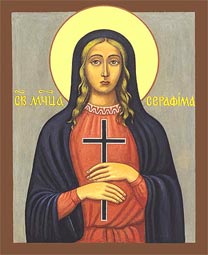 A maiden from Antioch, she lived in the house of one Sabina, wife of a senator, whom she brought to the Christian faith. Hearing of her, Virilus, a torturer of Christians, ordered that she be brought before him. As Seraphima remained steadfast in her faith, the torturer ordered that she be cast into prison, and he sent some young men to spend the night with her and defile her. Seraphima was praying to God in the prison when the young men arrived at the door. There, suddenly, an angel of God appeared in light before them with a sword in his hand, and they fell as dead, utterly without consciousness and incapable of movement. The following day, a torturer begged Seraphima to restore the young men to consciousness by her prayers. Dismissing all this as magic, Virilus ordered that this holy maiden be burned with torches and then beaten with rods. When they were beating her, a piece of rod broke off and flew through the air, striking Virilus in the eye and blinding him. Finally, this handmaid of Christ was beheaded and gave her soul to God. The devout Sabina buried her body, from which a healing myrrh began to flow. St Seraphima suffered during the reign of the Emperor Hadrian (117-138). A maiden from Antioch, she lived in the house of one Sabina, wife of a senator, whom she brought to the Christian faith. Hearing of her, Virilus, a torturer of Christians, ordered that she be brought before him. As Seraphima remained steadfast in her faith, the torturer ordered that she be cast into prison, and he sent some young men to spend the night with her and defile her. Seraphima was praying to God in the prison when the young men arrived at the door. There, suddenly, an angel of God appeared in light before them with a sword in his hand, and they fell as dead, utterly without consciousness and incapable of movement. The following day, a torturer begged Seraphima to restore the young men to consciousness by her prayers. Dismissing all this as magic, Virilus ordered that this holy maiden be burned with torches and then beaten with rods. When they were beating her, a piece of rod broke off and flew through the air, striking Virilus in the eye and blinding him. Finally, this handmaid of Christ was beheaded and gave her soul to God. The devout Sabina buried her body, from which a healing myrrh began to flow. St Seraphima suffered during the reign of the Emperor Hadrian (117-138).The Holy Martyr TheodotiaA young widow with three children, Theodotia laboured in the service of God in Salonica, together with St Anastasia (see December 22nd). In the time of Diocletian"s persecution, she was condemned to death and thrown into a fiery furnace together with her three children. Their holy souls soared up to their heavenly abode.
The Holy Martyr Eustathius of Mtskhet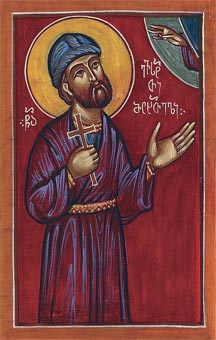 A Persian, born in the village of Arbuket, he went to the town of Mtskhet at the age of thirty and, seeing the life and faith of the Christians, received baptism. He was tortured for Christ and beheaded in Tiflis in 589. His relics are preserved in the cathedral at Mtskhet, and give healing to the faithful. A Persian, born in the village of Arbuket, he went to the town of Mtskhet at the age of thirty and, seeing the life and faith of the Christians, received baptism. He was tortured for Christ and beheaded in Tiflis in 589. His relics are preserved in the cathedral at Mtskhet, and give healing to the faithful.St. Constantine, patriarch of Constantinople (676)
St. Theodosius the New, emperor (450)Martyrs Benjamin and Berius of Constantinople
Martyr Mamas in Darii
Martyr Basiliscus the Elder
Venerable Romanus, abbot of Kirzhach (1392)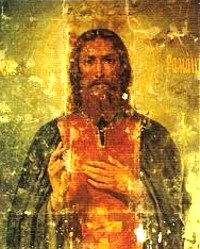 The Monk Roman of Kirzhachsk was a co-ascetic and student of the Monk Sergei, Hegumen of Radonezh (Comm. 25 September and 5 July). The Monks Sergei and Roman in the forests of Vladimir governance at the River Kirzhach built there a church in honour of the Annunciation of the MostHoly Mother of God, and established a new monastery (in 1371). Three years later, with the blessing of Saint Alexei, Metropolitan of Moscow (Comm. 12 February), the Monk Sergei returned to the Troitsky-Trinity monastery, and the Monk Roman remained to head the newly-created wilderness monastery... The Monk Roman of Kirzhachsk was a co-ascetic and student of the Monk Sergei, Hegumen of Radonezh (Comm. 25 September and 5 July). The Monks Sergei and Roman in the forests of Vladimir governance at the River Kirzhach built there a church in honour of the Annunciation of the MostHoly Mother of God, and established a new monastery (in 1371). Three years later, with the blessing of Saint Alexei, Metropolitan of Moscow (Comm. 12 February), the Monk Sergei returned to the Troitsky-Trinity monastery, and the Monk Roman remained to head the newly-created wilderness monastery...Venerables Constantine and Cosmas, abbots of Kosinsk (Pskov) (13th c.)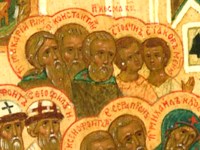 The Monks Konstantin and Kosma were monastic students of the Monk Varlaam of Khutynsk (+ 1192, Comm. 6 November) and his successor, the Monk Antonii of Dymsk (+ 1224, Comm. 17 January). In about the year 1220, having left the Khutynsk monastery, they settled upon a wilderness peninsula, situated 3 versts from the city of Staraya Russa, between the Rivers Polista and Smezhnya, and in time they founded there a monastery in the name of Saint Nicholas, headed by the Monk Konstantin until his death (+ c. 1240).
The Monk Kosma continued with the exploits of his mentor. He was buried in the same grave with the Monk Konstantin. Their bodies rest beneathe the vestibule of the Nikolaev church, built in 1820 upon the place of burial of the saints. The Monks Konstantin and Kosma were monastic students of the Monk Varlaam of Khutynsk (+ 1192, Comm. 6 November) and his successor, the Monk Antonii of Dymsk (+ 1224, Comm. 17 January). In about the year 1220, having left the Khutynsk monastery, they settled upon a wilderness peninsula, situated 3 versts from the city of Staraya Russa, between the Rivers Polista and Smezhnya, and in time they founded there a monastery in the name of Saint Nicholas, headed by the Monk Konstantin until his death (+ c. 1240).
The Monk Kosma continued with the exploits of his mentor. He was buried in the same grave with the Monk Konstantin. Their bodies rest beneathe the vestibule of the Nikolaev church, built in 1820 upon the place of burial of the saints. |